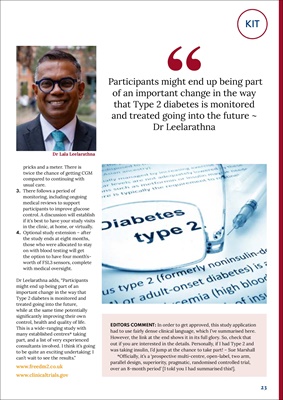
23
KIT
Participants might end up being part
of an important change in the way
that Type 2 diabetes is monitored
and treated going into the future ~
Dr Leelarathna
pricks and a meter. There is
twice the chance of getting CGM
compared to continuing with
usual care.
3. There follows a period of
monitoring, including ongoing
medical reviews to support
participants to improve glucose
control. A discussion will establish
if it's best to have your study visits
in the clinic, at home, or virtually.
4. Optional study extension - after
the study ends at eight months,
those who were allocated to stay
on with blood testing will get
the option to have four month'sworth
of FSL3 sensors, complete
with medical oversight.
Dr Leelarathna adds, "Participants
might end up being part of an
important change in the way that
Type 2 diabetes is monitored and
treated going into the future,
while at the same time potentially
significantly improving their own
control, health and quality of life.
This is a wide-ranging study with
many established centres* taking
part, and a list of very experienced
consultants involved. I think it's going
to be quite an exciting undertaking; I
can't wait to see the results."
www.freedm2.co.uk
www.clinicaltrials.gov
EDITORS COMMENT: In order to get approved, this study application
had to use fairly dense clinical language, which I've summarised here.
However, the link at the end shows it in its full glory. So, check that
out if you are interested in the details. Personally, if I had Type 2 and
was taking insulin, I'd jump at the chance to take part! - Sue Marshall
*Officially, it's a 'prospective multi-centre, open-label, two arm,
parallel design, superiority, pragmatic, randomised controlled trial,
over an 8-month period' [I told you I had summarised this!].
Dr Lala Leelarathna